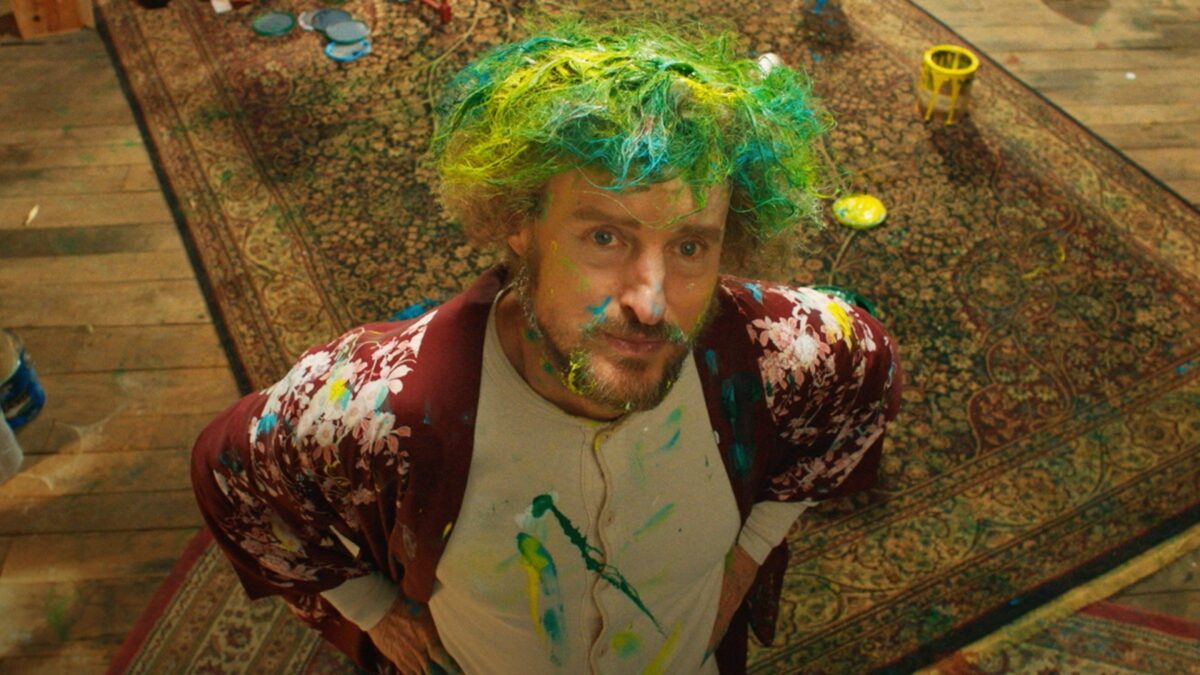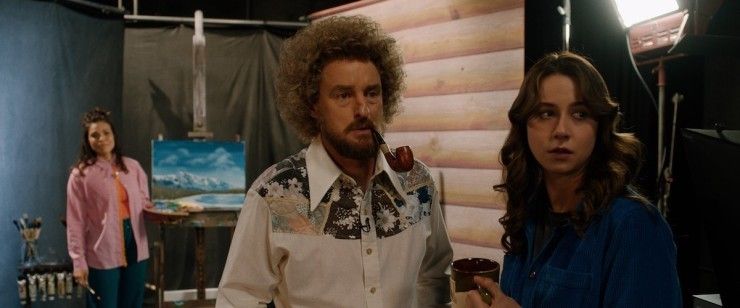
How do you capture a film’s theme through costume design?
Paint tells the story of the failing romantic and professional lives of Carl Nargle (Owen Wilson), the most popular cable television painter in Vermont. While Carl is largely inspired by Bob Ross, this is not a Bob Ross story. Instead, this is a film that is entirely focused on the downfall of someone beloved by his local community. Obscurity is inevitable for Carl as the world changes around him, and costume designer Allison Pearce captures this perfectly through the look of each character in Paint.
Over email, I discussed with Pearce her work on Paint, her love for vintage shopping, and how costume designing for film has changed for her over the years.
Editor’s Note: This interview has been edited for length and clarity.
No Film School: What was it like working with Brit McAdams? What did your discussion with McAdams about the costumes look like, what was the goal?
Allison Pearce: It was super fun working with Brit because he loves to tie in costumes to his writing. The comedy elements in Paint are often physical or literal jokes with costumes, giving me a lot of creative freedom to decide how to execute. The goal was to create this quirky little world – a made-up, set in the past version of Burlington, Vermont, PBS television. All the major elements needed to coalesce together — costumes, sets, props, hair, lighting.
Brit wanted to build a little world where everything was connected. For me, that meant using color palettes to match furniture, sets, and Carl’s van. It all needs to come together and envelope the audience with color and texture. Carl’s color palette is earth tones and vintage leather, and he matches the interior of his van. Or, Wendi, played by Wendy McClendon Covey, wears a lot of baby pink, mauve, and sage green, and those are the colors of the PBS Vermont station. It was a fun challenge!
NFS: What was the research process for creating these costumes?
Pearce: I narrowed down Carl Nargle’s character after talking with Brit. Some inspirations included Gordon Lightfoot, Kris Kristofferson, and Steve McQueen in the 1970s. California 1970s rock star/movie star in an accessible way by using vintage denim, worn leather, and embroidery. Of course, Bob Ross was an inspiration. Bob Ross was included in the initial conversations when I was deciding what Carl should look like, but it wasn’t part of the everyday. I wanted to differentiate this character and help build him a world of his own.
NFS: Where did you source the costumes from? Were they mostly handmade or rented? What were some of the places that you went to for vintage hunting?
Pearce: This film had a nice mixture of vintage, rented, and handmade costumes. Whenever I start a project that’s period or has period elements to it, I start at my vintage dealer in Philadelphia – Bulk Vintage Warehouse. Their vintage comes from sources all over the world and arrives in large bales. My team and I go there, and in this case, I told them we were looking for everyday late 1970s men’s Western snap front shirts, and they’ll open a bale for me that’s specifically men’s 1970s shirting.
Oftentimes, the best pieces are at the very bottom of this huge box. The boxes are much bigger than me. We might spend hours looking through vintage, but it’s always worth it. For Black Bear, Chris Abbott wears an M65 Army green fatigue field jacket, and I needed 5-6 multiples, and I found them there! Which is really very special. Bulk vintage often has deadstock pieces which means they were never worn, and they’re multiples from a buyout of a store that went out of business and kept their stock from however many years ago. It’s an amazing resource for me.
For Paint, we were shooting up in Saratoga Springs, which has a lot of vintage dealers. I hit up Hudson, NY, a lot for vintage — there’s a big indoor antique mall I like called Hudson Antique Warehouse. Nikki Chasin is an amazing independent designer I worked with to help build Ambrosia’s character, and her store is local to where we were shooting. For Ambrosia, we ended up building a lot of her pieces. I wanted her character to look handcrafted — like part of her art was making wearable pieces. In the first “Paint with Ambrosia,” she’s wearing this cropped cowl neck sweater. That was a huge hand-knit poncho I found in a thrift store for $5 that we reworked into a top. Almost all of Katharine’s costumes are vintage sweaters, with some sustainable brands mixed in, like Lacausa, a B corp from California. There’s a great rental house we worked with in Albany called Daybreak. I found a lot of Tony’s amazing sweaters there — and Carl’s denim shearling 1970s JCPenney coat. I can give you a whole list of vintage resources up there if you want!
Vintage is definitely one of my favorite parts of my job. I grew up thrifting with my mother, Donna, and the thrill of sourcing something unique is still a driving force in my work. If I’m driving somewhere and see a little church thrift shop or barn sale, I will stop. You’ll never know what you’ll find that’s been in someone’s attic for 50 years.

NFS: Did you test any of these looks on camera? Did you run into any issues where a material or design didn’t read well on camera?
Pearce: Camera tests are so important for the costume designer. Luckily, Patrick McCady, our DP, encouraged me to test as many textures and prints as possible. I think I have an eye for what will read well, but sometimes the moray issue does still arise.
When I first started, moray was a huge deal because of the technology and resolution of the cameras we were using. Now the cameras are so high res that it hardly ever comes up.
The camera test was a great opportunity for us to fully put Carl’s look together, with hair, makeup, costumes, and props, and see if we needed to make any tweaks. I liked this idea for Carl to have a uniform look — he always wears a 1970s Western snap-front shirt with some interest in the yolk, whether it’s embroidery, patchwork, or painting. For the camera test, we tried all of them. Ricardo James was our Key Costumer for this film, and he did the day-to-day dressing of Owen in costume. I think we tried 20 different shirts on for the test. It’s super important for me to see everything on camera in advance and decide where I poignantly want to use each piece. When Carl is at rock bottom, I put him in a shirt without any interest in it — like he’s lost his pizazz.
NFS: Can it be difficult to navigate between the trusts and interests of the director and the cast?
Pearce: Yes, definitely. But, for Paint, I know that every cast member I fit was super on board with the story and building this quirky little world. When I called Wendi, and I want to add that I’m such a fan, I had to say, “So Brit wants your character to wear Juicy Couture tracksuits.” I had a rack behind me for our first Zoom, and I showed her exactly what I had. It was a pretty funny conversation, but she was super game! I like to be as specific as possible when I meet with cast members, and I will show them, my costume boards, of course. When an actor takes a role, the costumes are often the first time they visually see the character come to life.
NFS: Did you have a favorite costume from the film?
Pearce: Ambrosia’s cream-collared jumpsuit with the antique patchwork blankets sewn into the seams. Our props team, Thor and Noa, were out looking for pieces for their prop world, and I had mentioned to them and our Set Decorator that I was looking for some amazing handmade and antique blankets for Ambrosia. Noa found this blanket at some thrift shop in Saratoga Springs. With the help of my team member Sarah Scapansky, we transformed this look and made it special. I really love the way this costume turned out.
NFS: What were some of the challenges you faced in the design process?
Pearce: We shot this film during COVID-19, so that was the main challenge. But our producers, Rick Bosner and Amy Jarvela, did a great job making our sets safe for everyone. My team had no covid positive cases, which was amazing. Design-wise, the challenges were that there were so many costumes in this film. I think Owen has 36 changes, and even though Carl Nargle wears a “uniform,” so to speak, he does change every day. Plus, all the flashbacks. Katherine is not far behind him, with many changes as well. With so many changes, staying on task with your character arcs can sometimes be challenging.
NFS: Do you have any advice for costume designers?
Pearce: Trust your instincts. It took me a while to get comfortable trusting my gut, and I know I’m better for it. Working at SNL taught me to follow my instincts, and I think it’s a great asset.














